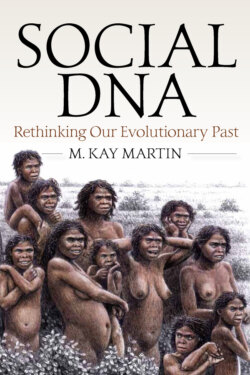Читать книгу Social DNA - M. Kay Martin - Страница 16
На сайте Литреса книга снята с продажи.
Humans as Chameleons
ОглавлениеThe prevailing theme in the following chapters is that what set hominins off on a separate evolutionary trajectory—what made us human—was the ability to flex our reproductive and social strategies in response to stochastic conditions. This perspective directly contradicts prevailing monotypic models of Paleolithic life that rely on the genetic imprinting of trait clusters born in Plio-Pleistocene hunting economies. If there is such a thing as a human biogram, it is not a staid template that was perfected for all time in a single ancient biome, but rather the capacity of evolving hominins for plasticity—the ability to tailor their behaviors and adaptations to meet the challenges of changing environmental conditions. This represents a fundamental shift in our perception of human nature and of the hominin evolutionary journey.
This book will argue that human lineages evolved in dynamic mosaic landscapes that selected for flexible rather than rigid adaptive responses. It explores new cross-disciplinary research that links the capacity for behavioral plasticity to critical changes in the structure and organization of the primate brain. Unlike contemporary apes, such as chimpanzees, early humans were equipped with a set of both hardwired genetic codes and “soft inheritance” rules—social DNA—that provided not one, but a menu of standard options for the organization of reproductive and socioeconomic life. What emerges from this discussion is a model of Paleolithic society that challenges prevailing theory on issues such as ancient diet, group size, encephalization, labor division, mating behaviors, and variable systems of kin affiliation. This discussion is undertaken from the perspective of multilevel selection, which addresses how the flexible organization of group life has structured the distribution of fitness-related resources through time.
Chapter 1 begins this journey at the beginning, namely, with conception and an exploration of how differing perspectives on human reproductive biology have influenced past and current theory about male and female natures and their strategies for inclusive fitness. A salient issue is whether the sexes are viewed as pursuing their fitness through cooperative partnerships, or at one another’s expense.
Chapter 2 considers how our mammalian origins and multilevel selective pressures may have shaped the evolution of proto-human family groups. Prevailing androcentric models of primeval families are critically evaluated. These theories are then contrasted with alternative perspectives based on the matricentric family, cooperative breeding, and the optimization of male and female fitness within the framework of multimale-multifemale groups.
Chapter 3 addresses the emergence of our genus in the late Pliocene, and considers recent data on the paleoecological conditions thought to have played a role in the evolution and geographic radiation of Homo erectus. Contrasting theories on the relative importance of terrestrial and aquatic fauna are examined, and an alternative evolutionary scenario offered that links dietary, morphological, and life history changes in early humans with fundamental shifts in female subsistence and reproductive strategies.
Chapter 4 explores more fully the potential range of dietary protein available to hominins throughout the Pleistocene, and the extent to which assumed reliance on the hunting of mammalian herbivores has influenced the reconstruction of Paleolithic economic and social life. In short, diverse biomes translate into diverse adaptations. Dietary breadth is regarded as a key issue for paleontological questions involving all hominin lineages, including the geographic expansions of Homo erectus and anatomically modern humans, and the ultimate fate of Neanderthals.
Chapter 5 pauses to consider signature traits that have characterized the hominin experience through time—the essential qualities that define and bind together both ancient and modern humans. Featured topics include opportunistic omnivory, spatiotemporal awareness, mating patterns, behavioral plasticity, intelligence, social demography, and changes in energetics. This chapter serves as a reminder of the qualities that made hominins unique among primates, and that separate us from other ancient and contemporary nonhuman apes.
Chapter 6 returns to the role played by kinship in structuring human adaptations through time. This chapter explores how kinship has been historically portrayed in anthropological theory and how notions about ancient subsistence patterns, innate dominance, inclusive fitness, and biobehavioral traits shared with contemporary apes have biased our perception of Paleolithic social life. Prevailing theories are reviewed and critiqued, and new genomic evidence is introduced that sheds light on the potential nature of early hominin social groups.
Finally, Chapter 7 addresses the long-standing debate among anthropologists and sociobiologists on the antecedents of matrilineal, patrilineal, and bilateral kinship systems. Kinship is examined as a technology for human niche construction that has allowed humans to manage the two basic elements of fitness—food and sex—by structuring their mating relationships and their social groups in a manner that optimized the recovery of energy and other fitness-related resources in a given ecological setting. The author’s perspective on factors that select for uterine and agnatic organization is explored by noting their distinct architectures for structuring reproductive, labor, and political groups in relation to available resources. The chapter explores both the origins and resiliency of matrilineal and patrilineal systems and how these variable strategies for niche construction have responded to change in the post-Neolithic era.
This book will be guided by the initial assumptions presented here. Its story on the origins and nature of human sociality blends mainstream theory and empirical data with some nuanced plot twists. To the extent that its conclusions challenge popular notions about our evolutionary past, the reader is reminded that this endeavor naturally summons a number of theanthropic questions, the answers to which no one really knows for sure.
